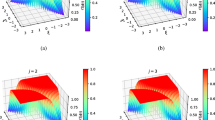Abstract
We study the quantum correlation dynamics of bipartite spin-\(\frac {1}{2}\) density matrices for two particles under Wigner rotations induced by Lorentz transformations which is transmitted through noisy channels. We compare quantum entanglement, geometric discord(GD), and quantum discord (QD) for bipartite relativistic spin-\(\frac {1}{2}\) states under noisy channels. We find out QD and GD tend to death asymptotically but a sudden change in the decay rate of the entanglement occurs under noisy channels. Also, bipartite relativistic spin density matrices are considered as a quantum channel for teleportation one-qubit state under the influence of depolarizing noise and compare fidelity for various velocities of observers.














Similar content being viewed by others
References
Nielsen, M.A., Chuang, I.L.: Quantum Computation and Quantum Information. Cambridge University Press, Cambridge (2000)
Goyal, S.K., Banerjee, S., Ghosh, S.: Phys. Rev. A 85, 012327 (2012)
Ollivier, H., Zurek, W.H.: Phys. Rev. Lett. 88, 017901 (2001)
Henderson, L., Vedral, V.: Classical, quantum and total correlations. J. Phys. A 34, 6899 (2001)
Mazaher, A., Rau, A.R.P., Alber, G.: Phys. Rev. A 81, 042105 (2010)
Dakic, B., Vedral, V., Brukner, C.: Phys. Rev. Lett. 105, 190502 (2010)
Girolami, D., Adesso, G.: Phys. Rev. A 83, 052108 (2011)
Jafarizadeh, M.A., Mahdian, M.: Int. J. Quantum Inf. (IJQI) v(3), 517–528 (2010)
Jafarizadeh, M.A., Mahdian, M.: Quantum Inf. Process (2010). doi:10.1007/s11128-010-0206-X
Jafarizadeh, M.A., Mahdian, M.: Quantum Inf. Process (2010). doi:10.1007/s11128-011-0289-Z
lamata, L., Leon, J., Salgado, D.: Phys. Rev. A 73, 052325 (2006)
Peres, A., Scudo, P.F., Terno, D.R.: Phys. Rev. Lett. 88(23) (2002)
Ahn, D., Lee, H.J., Moon, Y.H., Hwang, S.W.: Relativistic entanglement and Bell?s inequality. Phys. Rev. A 67, 012103 (2003)
Siomau, M., Fritzsche, S.: Phys. J. D 60, 397–403 (2010)
Moy, G.M., Hope, J.J., Savage, C.M.: Phys. Rev. A 59, 667–675 (1999)
Kraus, K.: States, Effects and Operations: Fundamen-tal Notions of Quantum Theory. Springer-Verlag, Berlin (1983)
Kraus, K.: States, Effects and Operations. Spring-Verlag, Berlin (1983)
Davies, E.B.: Quantum Theory of Open Systems. Academic, London (1976)
Preskill, J.: Lecture notes: Information for Physics 219/Computer Science 219, Quantum Computation, www.theory.caltech.edu/people/preskill/ph229.5
Kraus, K.: General state changes in quantum theory. Ann. Phys. 64(2), 311–335 (1971)
Choi, M.: Completely positive linear maps on complex matrices. Linear Algebra Appl. 10, 285–290 (1975)
Bouda, J., Buzek, V.: Purification and correlated measurements of bipartite mixed states. Phys. Rev. A 65, 034304 (2003)
Benenti, G., Casati, G., Strini, G.: Principles of Quantum Computation and Information, vol. 2. World Scientific, Singapore (2007)
Lindblad, G.: Commun. Math. Phys. 48, 119 (1976)
Streltsov, A., Kampermann, H., Bruß, D.: PRL 107, 170502 (2011)
Yu, T., Eberly, J.H.: Phys. Rev. Lett. 97, 140403 (2006)
Chun, M., Ming, Y., Zhuo-Liang, C.: Commun. Theor. Phys.(Beijing, China) 53, 489–495 (2010)
Oh, S., Lee, S., Lee, H.-W.: Phys. Rev. A 66, 22316 (2002)
Yan-Ling, L., Mao-Fa, F., Xing, X., Chao, W., Li-Zhen, H.: Chin. Phys. B 19(6), 060306 (2010)
Wootters, W.K.: Entanglement of formation of an arbitrary state of two qubits. Phys. Rev. Lett. 80, 2245 (1998)
Gyongyosi, L., Imre, S.: Properties of the quantum channel. arXiv:1208.1270 [quant-ph]
Dodd, P.J., Halliwell, J.J.: Phys. Rev. A 69, 052105 (2004)
Bennett, C.H., et al.: Teleportation an unknown quantum state via dual classical and Einstein-Podolsky-Rosen channels. Phys. Rev. Lett. 70, 1895 (1993)
Hu, M.-L.: Environment-induced decay of teleportation fidelity of the one-qubit state. Phys. Lett. A 375(21) (2011)
Weinberg, S.: The Quantum Theory of Fields I. Cambridge University Press, NY (1995)
Wigner, E.P.: On unitary representations of the inhomogeneous Lorentz group. Ann. Math. 40, 149 (1939)
Andersson, E., Cresser, J.D., Hall, M.J.W.: Finding the Kraus decomposition from a master equation and vice versa. J. Mod. Opt. (2007)
Mahdian, M., Mehrabpour, H.: Nakajima-Zwanzig and time-convoulutionless master equation for a one-qubit system in a non-markovian layered environment. J. Theor. Phys. (2014)
Author information
Authors and Affiliations
Corresponding author
Appendix A
Appendix A
Wigner representation for spin-\(\frac {1}{2}\): It follows [35] that the effect of an arbitrary Lorentz transformation unitarily implemented as U(Λ) on single-particle states is as follow
where
is the Wigner rotation [36]. The Wigner rotation is an element of the spacial rotation group S O(3) or subgroup of the homogeneous Lorentz group since it leaves the rest momentum k ν unchanged:
This subgroup is called (Wigner's) little group. We will consider two reference frames in this work: one is the rest frame S and the other is the moving frame \(S^{\prime }\) in which a particle whose four-momentum p in S is seen as boosted with the velocity \( \vec {\upsilon }.\) By setting the boost and particle moving directions in the rest frame to be \(\hat {\upsilon }\) with \(\hat {e}\) as the normal vector in the boost direction and \(\hat {p_{1,(2)}}\), respectively, and \(\hat {n}=\hat {e}\times \hat {p_{1,(2)}}\) the Wigner representation for spin-\(\frac {1}{2}\) is found as [13],
where
and
Note, in this paper we consider the boost in the x direction and the momentum vector in the z direction. Then after some calculation we get the Wigner representation \(D^{\frac {1}{2}}(W({\Lambda },p_{1,(2)}))\) for spin-\(\frac {1}{2}\) as:
Rights and permissions
About this article
Cite this article
Mahdian, M., Mojaveri, B., Dehghani, A. et al. Quantum Correlations of Two Relativistic Spin-\(\frac {1}{2}\) Particles Under Noisy Channels. Int J Theor Phys 55, 678–697 (2016). https://doi.org/10.1007/s10773-015-2705-0
Received:
Accepted:
Published:
Issue Date:
DOI: https://doi.org/10.1007/s10773-015-2705-0




